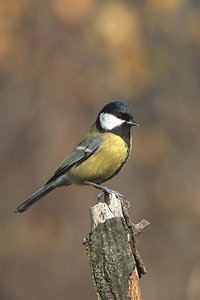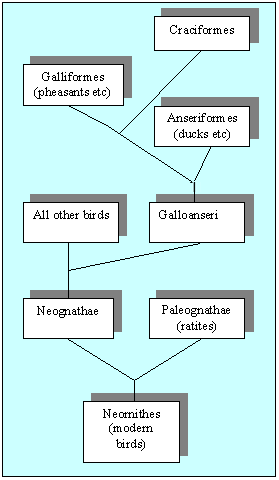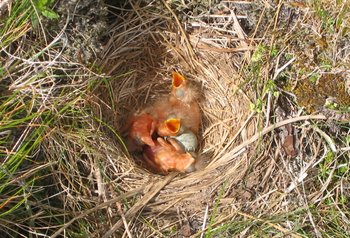Bird
Birds are bipedal, warm-blooded, egg-laying vertebrates characterized primarily by feathers, forelimbs modified as wings, and hollow bones. more...
Birds range in size from the tiny hummingbirds to the huge Ostrich and Emu. more...
Depending on taxonomic viewpoint, there are about 8,800–10,200 living bird species (plus about 120–130 that have become extinct in the span of human history) in the world, making them the most diverse class of terrestrial vertebrates.
Birds are a very differentiated class, with some feeding on nectar, plants, seeds, insects, rodents, fish, carrion, or other birds. Most birds are diurnal, or active during the day. Some birds, such as the owls and nightjars, are nocturnal or crepuscular (active during twilight hours). Many birds migrate long distances to utilise optimum habitats (e.g., Arctic Tern) while others spend almost all their time at sea (e.g. the Wandering Albatross). Some, such as frigatebirds, stay aloft for days at a time, even sleeping on the wing.
Common characteristics of birds include a bony beak with no teeth, the laying of hard-shelled eggs, high metabolic rate, and a light but strong skeletons. Most birds are characterised by flight, though the ratites are flightless, and several other species, particularly on islands, have also lost this ability. Flightless birds include the penguins, Ostrich, kiwi, and the extinct Dodo. Flightless species are vulnerable to extinction when humans or the mammals they introduce arrive in their habitat, for example the Great Auk, flightless rails, and the moa of New Zealand.
Bird orders
This is a list of the taxonomic orders in the class Aves. The list of birds gives a more detailed summary, including families.
- Struthioniformes, Ostrich, emus, kiwis, and allies
- Tinamiformes, tinamous
- Anseriformes, waterfowl
- Galliformes, fowl
- Sphenisciformes, penguins
- Gaviiformes, loons
- Podicipediformes, grebes
- Procellariiformes, albatrosses, petrels, and allies
- Pelecaniformes, pelicans and allies
- Ciconiiformes, storks and allies
- Phoenicopteriformes, flamingos
- Accipitriformes, eagles, hawks and allies
- Falconiformes, falcons
- Turniciformes, button-quail
- Gruiformes, cranes and allies
- Charadriiformes, plovers and allies
- Pteroclidiformes, sandgrouse
- Columbiformes, doves and pigeons
- Psittaciformes, parrots and allies
- Cuculiformes, cuckoos
- Strigiformes, owls
- Caprimulgiformes, nightjars and allies
- Apodiformes, swifts
- Trochiliformes, hummingbirds
- Coraciiformes, kingfishers
- Piciformes, woodpeckers and allies
- Trogoniformes, trogons
- Coliiformes, mousebirds
- Passeriformes, passerines
Note: This is the traditional classification (the so-called Clements order). A more recent, radically different classification based on molecular data has been developed (the so-called Sibley order) and is gaining acceptance.
Evolution
Birds are generally considered to have evolved from theropod dinosaurs. Specifically, birds are members of Maniraptora, a group of theropods which includes dromaeosaurs and oviraptorids, among others. As more non-avian theropods that are closely related to birds are discovered, the formerly clear distinction between non-birds and birds becomes less so. Recent discoveries in North-east China (Liaoning Province) demonstrating that many small theropod dinosaurs had feathers contribute to this ambiguity.
The basal bird Archaeopteryx, from the Jurassic, is well-known as one of the first "missing links" to be found in support of evolution in the late 19th century. It remains the most primitive known bird. Other Mesozoic birds include the Confuciusornithidae, Enantiornithes, Ichthyornis, and Hesperornithiformes, a group of flightless divers resembling grebes and loons.
The recently discovered dromaeosaur, Cryptovolans, was capable of powered flight, contained a keel and had ribs with uncinate processes. In fact, Cryptovolans makes a better "bird" than Archaeopteryx which is missing some of these modern bird features. Because of this, some paleontologists have suggested that dromaeosaurs are actually basal birds whose larger members are secondarily flightless, i.e. dromaeosaurs evolved from birds and not the other way around. Evidence for this theory is currently inconclusive, but digs continue to unearth fossils (especially in China) of the strange feathered dromaeosaurs.
It should be noted that although ornithischian (bird-hipped) dinosaurs share the same hip structure as birds, birds actually originated from the saurischian (lizard-hipped) dinosaurs, and thus arrived at their hip structure condition independently. In fact, the bird-like hip structure developed a third time among a peculiar group of theropods, the Therizinosauridae.
Modern birds are classified in Neornithes, which are split into the Paleognathae and Neognathae. The paleognaths include the tinamous (found only in Central and South America) and the ratites. The ratites are large flightless birds, and include ostriches, cassowaries, kiwis and emus; some scientists suspect that the ratites represent an artificial grouping of birds which have independently lost the ability to fly, others contend that the ratites never had the ability to fly and are more directly related to the dinosaurs. The basal divergence from the remaining Neognathes was that of the Galloanseri, the superorder containing the Anseriformes (ducks, geese and swans), and the Galliformes (the pheasants, grouse, and their allies). See the chart.
The classification of birds is a contentious issue. Sibley & Ahlquist's Phylogeny and Classification of Birds (1990) is a landmark work on the classification of birds (although frequently debated and constantly revised). Evidence for the various orders seems to be fairly good, but the relationships between the orders are in a state of disarray. Evidence from modern bird anatomy, fossils and DNA have all been brought to bear on the problem but no strong consensus has emerged. See also: Sibley-Ahlquist taxonomy.
Read more at Wikipedia.org





